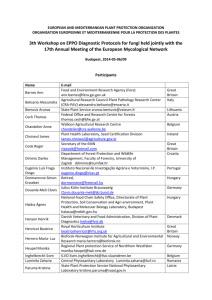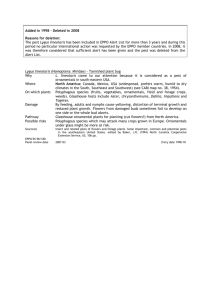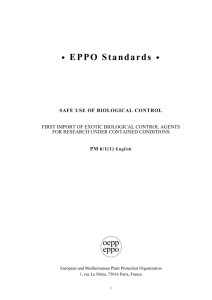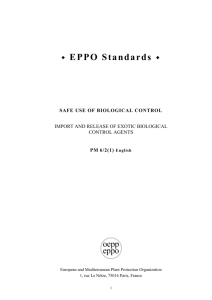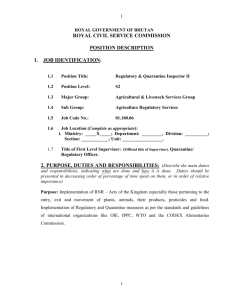Quarantine regulations - World Federation for Culture Collections
advertisement
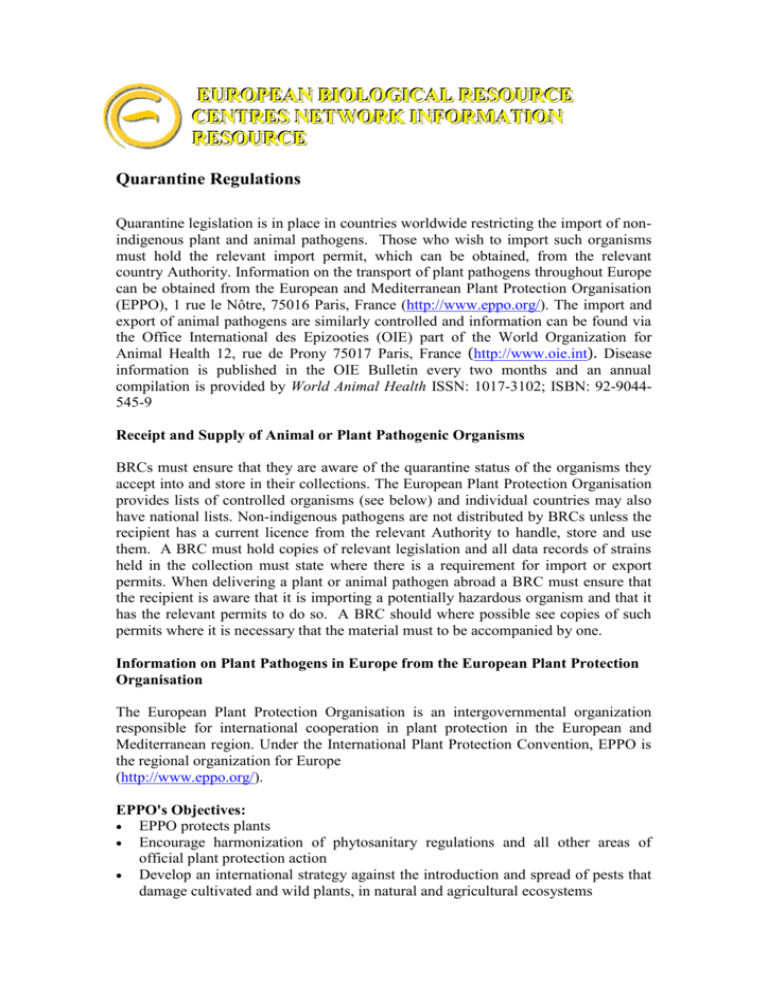
E EU UR RO OPPE EA AN NB BIIO OL LO OG GIIC CA AL LR RE ESSO OU UR RC CE E C CE EN NT TR RE ESS N NE ET TW WO OR RK K IIN NFFO OR RM MA AT TIIO ON N R RE ESSO OU UR RC CE E Quarantine Regulations Quarantine legislation is in place in countries worldwide restricting the import of nonindigenous plant and animal pathogens. Those who wish to import such organisms must hold the relevant import permit, which can be obtained, from the relevant country Authority. Information on the transport of plant pathogens throughout Europe can be obtained from the European and Mediterranean Plant Protection Organisation (EPPO), 1 rue le Nôtre, 75016 Paris, France (http://www.eppo.org/). The import and export of animal pathogens are similarly controlled and information can be found via the Office International des Epizooties (OIE) part of the World Organization for Animal Health 12, rue de Prony 75017 Paris, France (http://www.oie.int). Disease information is published in the OIE Bulletin every two months and an annual compilation is provided by World Animal Health ISSN: 1017-3102; ISBN: 92-9044545-9 Receipt and Supply of Animal or Plant Pathogenic Organisms BRCs must ensure that they are aware of the quarantine status of the organisms they accept into and store in their collections. The European Plant Protection Organisation provides lists of controlled organisms (see below) and individual countries may also have national lists. Non-indigenous pathogens are not distributed by BRCs unless the recipient has a current licence from the relevant Authority to handle, store and use them. A BRC must hold copies of relevant legislation and all data records of strains held in the collection must state where there is a requirement for import or export permits. When delivering a plant or animal pathogen abroad a BRC must ensure that the recipient is aware that it is importing a potentially hazardous organism and that it has the relevant permits to do so. A BRC should where possible see copies of such permits where it is necessary that the material must to be accompanied by one. Information on Plant Pathogens in Europe from the European Plant Protection Organisation The European Plant Protection Organisation is an intergovernmental organization responsible for international cooperation in plant protection in the European and Mediterranean region. Under the International Plant Protection Convention, EPPO is the regional organization for Europe (http://www.eppo.org/). EPPO's Objectives: EPPO protects plants Encourage harmonization of phytosanitary regulations and all other areas of official plant protection action Develop an international strategy against the introduction and spread of pests that damage cultivated and wild plants, in natural and agricultural ecosystems Promote the use of modern, safe, and effective pest control methods Provide a documentation service on plant protection EPPO's Activities: Setting regional standards for phytosanitary measures and plant protection products Organizing Working Party and Panel meetings (see EPPO meetings) bringing together experts from all parts of the EPPO region EPPO is actively involved in global activities related to phytosanitary measures coordinated by the IPPC Secretariat within FAO. Organizing international conferences and workshops for plant protection researchers, managers of plant protection services, phytosanitary inspectors and other interested parties. Publishing the journal Bulletin OEPP/EPPO Bulletin, the EPPO Reporting Service and the EPPO Summaries of Phytosanitary Regulations, providing an electronic documentation service, distributing database systems. EPPO Quarantine information is available at: http://www.eppo.org/QUARANTINE/quarantine.html The activities of EPPO concern any aspect of plant protection in agriculture, forestry and horticulture with an international dimension, in which National Plant protection Organizations are involved. An important part of these activities is plant quarantine, as one of the aims of EPPO is to prevent entry or spread of dangerous pests. Information on quarantine pests (A1 & A2 lists, data sheets, maps etc.) Pest Risk Analysis EPPO Alert List Phytosanitary regulations EPPO Project on quarantine pests for forestry List of biological control agents widely used in the EPPO region Definitions in plant quarantine Data Sheets on Quarantine Pests The pests of the A1 and A2 lists (and EU annexes) are all covered by data sheets which give information on their host plants, geographical distribution, biology, economic importance, phytosanitary risk etc. http://www.eppo.org/QUARANTINE/Data sheets/datasheets.html The International Plant Protection Convention: http://www.ippc.int/servlet/CDSServlet?status=ND0xMzI5MiY3PWVuJjYxPSomNj U9aW5mbw%7E%7E Information on Animal Pathogens: The Office International des Epizooties (OIE), part of the World Organization for Animal Health The Office International des Epizooties (OIE) is an intergovernmental organisation created by the International Agreement of 25 January 1924, signed by 28 countries. In May 2002, the OIE totalled 162 Member Countries. Each Member Country undertakes to report the animal diseases that it detects on its territory. The OIE then disseminates the information to other countries, which can take the necessary preventive action. This information also includes diseases transmissible to humans. Information is sent out immediately or periodically depending on the seriousness of the disease. Dissemination is via the OIE Web site, email and the following periodicals: Disease Information, published weekly, the OIE Bulletin published every two months and the annual compilation World Animal Health. The OIE develops normative documents relating to rules that Member Countries can use to protect themselves from diseases, without setting up unjustified sanitary barriers. The main normative works produced by the OIE are: the International Animal Health Code, the Manual of Standards for Diagnostic Tests and Vaccines, the International Aquatic Animal Health Code and the Diagnostic Manual for Aquatic Animal Diseases. Examples/Example Procedures Clients in the UK who wish to obtain cultures of non-indigenous plant pathogens must first obtain a Ministry of Agriculture Fisheries and Food (MAFF) license. Under the terms of such a licence the shipper is required to see a copy of the Ministry permit before such strains can be supplied. Such licences are available in England and Wales from Ministry of Agriculture, Fisheries and Food, Room 340, Foss House, Kings Pool, 1-2 Peace Holme Green, York YO1 2PX and in Scotland from Plant Health Section, Agricultural Science Agency, East Craigs, Edinburgh EH12 8NJ. Nonindigenous tree pathogens can only be supplied if the customer holds a current permit issued by The Forestry Commission: Forestry Commission Headquarters, 231 Corsthorphine Road, Edinburgh EH12 7AP. All shipments to Canada and the USA for plant pathogens must be accompanied by import mailing labels, without which entry of cultures to these countries is refused. Applications for these labels, stating the names of the organisms and the purpose for which they are required, should be made for Canada to the Chief of the Plant Protection Division, Agriculture Canada Science Division, Science Service Building, Ottawa, Ontario, Canada K1AS 0C5 and for the USA to USDA Agricultural Research Service, Plant Protection & Quarantine, Room 764, 6505 Belcrest Road, Hyattsville, Maryland 20782, USA. Permit applications USA: http://www.aphis.usda.gov/ppq/permits/ USA Regulated Pest list: http://www.aphis.usda.gov/ppq/regpestlist/ In the UK the Specified Animal Pathogens Order 1998 makes it an offence to possess or spread a listed animal pathogen within Great Britain without a license. It is supplemented by the Importation of Animal Pathogens Order 1980 which makes it an offence to import any animal pathogen, or potential or actual carrier, of an animal pathogen from a non-EC country, except under licence. Enquiries should be directed to the Animal Health Division of MAFF. The organisms covered by this order are indicated in table 1 by the symbol M1. Collection staff should note that both the Culture Collection and the customer must hold the appropriate licences. Orders will be refused where the customer is unable to provide a copy of the appropriate licence.
